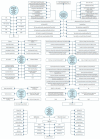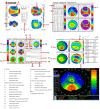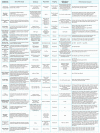Keratoconus Diagnosis: From Fundamentals to Artificial Intelligence: A Systematic Narrative Review
- PMID: 37627975
- PMCID: PMC10453081
- DOI: 10.3390/diagnostics13162715
Keratoconus Diagnosis: From Fundamentals to Artificial Intelligence: A Systematic Narrative Review
Abstract
The remarkable recent advances in managing keratoconus, the most common corneal ectasia, encouraged researchers to conduct further studies on the disease. Despite the abundance of information about keratoconus, debates persist regarding the detection of mild cases. Early detection plays a crucial role in facilitating less invasive treatments. This review encompasses corneal data ranging from the basic sciences to the application of artificial intelligence in keratoconus patients. Diagnostic systems utilize automated decision trees, support vector machines, and various types of neural networks, incorporating input from various corneal imaging equipment. Although the integration of artificial intelligence techniques into corneal imaging devices may take time, their popularity in clinical practice is increasing. Most of the studies reviewed herein demonstrate a high discriminatory power between normal and keratoconus cases, with a relatively lower discriminatory power for subclinical keratoconus.
Keywords: artificial intelligence; biomechanical phenomena; computer; corneal topography; deep learning; diagnosis; keratoconus; machine learning; neural networks; optical coherence.
Conflict of interest statement
No conflicting relationship exists for any author. All authors completed and submitted the ICMJE disclosure of interest form.
Figures









Similar articles
-
Keratoconus: exploring fundamentals and future perspectives - a comprehensive systematic review.Ther Adv Ophthalmol. 2024 Mar 20;16:25158414241232258. doi: 10.1177/25158414241232258. eCollection 2024 Jan-Dec. Ther Adv Ophthalmol. 2024. PMID: 38516169 Free PMC article. Review.
-
A Review of Machine Learning Techniques for Keratoconus Detection and Refractive Surgery Screening.Semin Ophthalmol. 2019;34(4):317-326. doi: 10.1080/08820538.2019.1620812. Epub 2019 Jun 9. Semin Ophthalmol. 2019. PMID: 31304857 Review.
-
Utility of artificial intelligence in the diagnosis and management of keratoconus: a systematic review.Front Ophthalmol (Lausanne). 2024 May 17;4:1380701. doi: 10.3389/fopht.2024.1380701. eCollection 2024. Front Ophthalmol (Lausanne). 2024. PMID: 38984114 Free PMC article.
-
Role of artificial intelligence, machine learning and deep learning models in corneal disorders - A narrative review.J Fr Ophtalmol. 2024 Sep;47(7):104242. doi: 10.1016/j.jfo.2024.104242. Epub 2024 Jul 15. J Fr Ophtalmol. 2024. PMID: 39013268 Review.
-
Corneal biomechanics in early diagnosis of keratoconus using artificial intelligence.Graefes Arch Clin Exp Ophthalmol. 2024 Apr;262(4):1337-1349. doi: 10.1007/s00417-023-06307-7. Epub 2023 Nov 9. Graefes Arch Clin Exp Ophthalmol. 2024. PMID: 37943332 Review.
Cited by
-
Systemic and Ocular Associations of Keratoconus.Expert Rev Ophthalmol. 2024;19(5):379-391. doi: 10.1080/17469899.2024.2368801. Epub 2024 Jul 3. Expert Rev Ophthalmol. 2024. PMID: 39494085 Free PMC article.
-
Biomechanical changes in keratoconus after customized stromal augmentation.Taiwan J Ophthalmol. 2024 Feb 20;14(1):59-69. doi: 10.4103/tjo.TJO-D-23-00155. eCollection 2024 Jan-Mar. Taiwan J Ophthalmol. 2024. PMID: 38654988 Free PMC article. Clinical Trial.
-
The Combined Utilization of Epithelial Thickness and Tomographic Parameters in Keratoconus Detection.J Ophthalmol. 2025 Mar 18;2025:6647993. doi: 10.1155/joph/6647993. eCollection 2025. J Ophthalmol. 2025. PMID: 40134610 Free PMC article.
-
Enhancing Ophthalmic Diagnosis and Treatment with Artificial Intelligence.Medicina (Kaunas). 2025 Feb 28;61(3):433. doi: 10.3390/medicina61030433. Medicina (Kaunas). 2025. PMID: 40142244 Free PMC article. Review.
-
Applications of machine learning in glaucoma diagnosis based on tabular data: a systematic review.BMC Biomed Eng. 2025 Aug 1;7(1):9. doi: 10.1186/s42490-025-00095-3. BMC Biomed Eng. 2025. PMID: 40745560 Free PMC article.
References
Publication types
LinkOut - more resources
Full Text Sources

